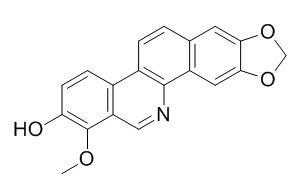Decarine
Decarine has high antibacterial activity against mycobacterial, gram-positive and gram-negative bacteria, and low cytotoxicity towards human macrophages.Decarine inhibits fMLP/CB-induced elastase release with IC(50) values < or = 5.53 microg/mL.
Inquire / Order:
manager@chemfaces.com
Technical Inquiries:
service@chemfaces.com
Tel:
+86-27-84237783
Fax:
+86-27-84254680
Address:
1 Building, No. 83, CheCheng Rd., Wuhan Economic and Technological Development Zone, Wuhan, Hubei 430056, PRC
Providing storage is as stated on the product vial and the vial is kept tightly sealed, the product can be stored for up to
24 months(2-8C).
Wherever possible, you should prepare and use solutions on the same day. However, if you need to make up stock solutions in advance, we recommend that you store the solution as aliquots in tightly sealed vials at -20C. Generally, these will be useable for up to two weeks. Before use, and prior to opening the vial we recommend that you allow your product to equilibrate to room temperature for at least 1 hour.
Need more advice on solubility, usage and handling? Please email to: service@chemfaces.com
The packaging of the product may have turned upside down during transportation, resulting in the natural compounds adhering to the neck or cap of the vial. take the vial out of its packaging and gently shake to let the compounds fall to the bottom of the vial. for liquid products, centrifuge at 200-500 RPM to gather the liquid at the bottom of the vial. try to avoid loss or contamination during handling.
Agronomy2020, 10(3),388.
Evid Based Complement Alternat Med.2020, 2020:9416962.
J Nat Med.2021, doi: 10.1007.
Phytomedicine.2019, 62:152962
Bioengineering2023, 10(10), 1113.
FEMS Microbiol Lett.2017, 364(11)
Arch Toxicol.2017, 91(10):3225-3245
Plant Cell, Tissue and Organ Culture (PCTOC)2024, 158:54
Oncol Rep.2021, 46(1):143.
Molecules.2019, 25(1):E103
Related and Featured Products
J Ethnopharmacol. 2013 Mar 7;146(1):417-22.
Zanthoxylum capense constituents with antimycobacterial activity against Mycobacterium tuberculosis in vitro and ex vivo within human macrophages.[Pubmed:
23337743]
METHODS AND RESULTS:
The best results were obtained for a benzophenanthridine alkaloid, Decarine (1), and an N-isobutylamide, N-isobutyl-(2E,4E)-2,4-tetradecadienamide (15), which showed high activity against Mycobacterium tuberculosis H37Rv (MIC of 1.6 μg/ml), and a low macrophage cytotoxicity (IC50>60 μg/ml), indicating considerable selective activity. The benzophenanthridine alkaloid 6-acetonyldihydronitidine (6) revealed cytotoxicity (IC50 1.7 μg/ml), despite the determined MIC of 6.2-12.5 μg/ml. In infected macrophages, Decarine (1) was able to reduce bacterial survival by almost two log units at a concentration of 6.2 μg/ml 5 days post-drug exposure. Compound 15 exhibited an intermediate activity at drug concentrations ranging from 6.2 to 25 μg/ml.
CONCLUSIONS:
The high antimycobacterial activity of Decarine found, both in vitro and ex vivo against mycobacteria, and the low cytotoxicity towards human macrophages indicate that it may be valuable as a lead scaffold for the development of anti-TB drugs.
Int J Mol Sci. 2013 Nov 13;14(11):22395-408.
New benzo[c]phenanthridine and benzenoid derivatives, and other constituents from Zanthoxylum ailanthoides: Effects on neutrophil pro-inflammatory responses.[Pubmed:
24232457]
METHODS AND RESULTS:
A new benzo[c]phenanthridine, oxynorchelerythrine (1), and two new benzenoid derivatives, methyl 4-(2-hydroxy-4-methoxy-3-methyl-4-oxobutoxy)benzoate (2) and (E)-methyl 4-(4-((Z)-3-methoxy-3-oxoprop-1-enyl)phenoxy)-2-methylbut-2-enoate (3), have been isolated from the twigs of Zanthoxylum ailanthoides, together with 11 known compounds (4-14). The structures of these new compounds were determined through spectroscopic and MS analyses.
CONCLUSIONS:
Among the isolated compounds, Decarine (4), (-)-syringaresinol (6), (+)-episesamin (8), glaberide I (9), (-)-dihydrocubebin (10), and xanthyletin (11) exhibited potent inhibition (IC50 values ≤ 4.79 µg/mL) of superoxide anion generation by human nutrophils in response to N-formyl-L-methionyl-L-leucyl-L-phenylalanine/cytochalasin B (fMLP/CB). Compounds 4, 8, and 11 also inhibited fMLP/CB-induced elastase release with IC50 values ≤ 5.48 µg/mL.
Planta Med. 2012 Jan;78(2):148-53.
Antibacterial benzofuran neolignans and benzophenanthridine alkaloids from the roots of Zanthoxylum capense.[Pubmed:
22002848]
METHODS AND RESULTS:
Two new 2-arylbenzofuran neolignans and a new benzophenanthridine alkaloid, together with six known benzophenanthridine alkaloids, namely, Decarine, norchelerythrine, dihydrochelerythrine, 6-acetonyldihydrochelerythrine, tridecanonchelerythrine, and 6-acetonyldihydronitidine, have been isolated from the MeOH extract of the roots of Zanthoxylum capense. Their structures were elucidated by means of spectroscopic techniques including 2D NMR experiments. All the isolated compounds were evaluated for their in vitro antibacterial activity against gram-positive and gram-negative bacteria.
CONCLUSIONS:
Some compounds showed significant inhibitory activity against Staphylococcus aureus ATCC 6538 with MIC values ranging from 12.5 to 50 μg/mL.
J Nat Prod. 2009 Jan;72(1):107-11.
Amides and benzenoids from Zanthoxylum ailanthoides with inhibitory activity on superoxide generation and elastase release by neutrophils.[Pubmed:
19128011]
METHODS AND RESULTS:
Five new compounds, ailanthamide (1), N-(4-methoxyphenethyl)-N-methylbenzamide (2), (2E,4E)-N-isobutyl-6-oxohepta-2,4-dienamide (3), 4-(4'-hydroxy-3'-methylbutoxy)benzaldehyde (4), and (E)-methyl 4-[4-(3-hydroxypropyl)phenoxy]-2-methylbut-2-enoate (5), and 17 known compounds have been isolated from the stem bark of Zanthoxylum ailanthoides. The structures were determined through spectroscopic and MS analyses.
CONCLUSIONS:
Compounds 1, 3, xanthyletin, Decarine, (+)-episesamin, (-)-hinokinin, and evofolin-B exhibited inhibition (IC(50) < or = 5.34 microg/mL) of superoxide anion generation by human neutrophils in response to formyl-l-methionyl-l-leucyl-l-phenylalanine/cytochalasin B (fMLP/CB).
Compounds 1, xanthyletin, Decarine, and (+)-episesamin also inhibited fMLP/CB-induced elastase release with IC(50) values < or = 5.53 microg/mL.



